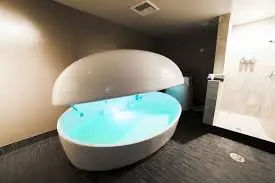Float Therapy
Table of Contents
Introduction
Float therapy, also known as sensory deprivation or isolation tank therapy, is a unique and immersive wellness practice that aims to promote relaxation, stress reduction, and mental well-being. Developed in the 1950s by neuroscientist John C. Lilly, float therapy involves the use of specially designed tanks or pods filled with a dense solution of Epsom salt and water, creating a buoyant environment where individuals can effortlessly float on the surface.
Your flotation treatment session will start in a calm, comfortable, and clean atmosphere that reduces outside distractions.
You may be able to relax by reducing stimuli when floating in a sensory deprivation tank.
According to some research, sensory deprivation tanks, also known as float therapy, can help with minor aches and pains, circulation issues, anxiety, and stress reduction. However, there isn’t enough data to say whether it works or is safe.
Float treatment could be a soothing experience if it entails floating in a sensory deprivation tank with little inputs. This is all the information you need to know about float therapy, including what to expect, how it operates, and potential advantages.
What Is Float Therapy?
Float therapy involves “floating” in a sensory deprivation tank filled with water, sometimes referred to as a floatation or isolation tank. Calming the body and mind is the aim of float treatment. The secret to the effectiveness of flotation therapy is REST. “Restricted environmental stimulation therapy” is what this refers for.
Sensory-deprivation tank therapy eliminates external stimuli such as changes in:
- Sound
- Light
- Temperature
- Your mind may become more peaceful and tranquil in the dimly lit space, thus reducing tension and anxiety. There is evidence to suggest that during float therapy, you become more conscious of your heartbeat and breathing, as well as your ability to control them. You consequently become more relaxed, which lowers your heart rate, blood pressure, and anxiety.
How Could It Impact the Brain?
A 2021 study observed that no research has examined the impact of float therapy on the brain up to that point. By lowering inputs, sensory deprivation tank therapy may help some patients with anxiety and tension. However, the researchers noted that there is little data to determine how the brain is affected by lower levels of motor and sensory input.
Functions of a float tank:
- Our 30% Epsom salt solution-filled floating tanks allow you to float effortlessly while counteracting the forces of gravity.
- There is minimal feeling because the solution and air are the same temperature as you.
- You have the option to turn off a light to lose sight.
- To reduce your sensation of hearing, the space is designed to be soundproof.
- No gravity.
- No light.
- No sound.
- Nothing at all.
Additional items in the float chamber include:
- A luxurious shower with brand-new towels and high-quality items so you may clean yourself before floating and rinse off the salt afterward
- Earplugs since floating will immerse your ears.
- Ointment to treat wounds, scratches, and areas that might be vulnerable to the salt solution
- Use a makeup remover to ensure you’re clean before entering.
- A pillow that floats to make you more comfortable
- To remove any salt from your face, use a washcloth and a spray bottle of fresh water.
- An ear flush with vinegar to get rid of salt
- Athletes, biohackers, people struggling with mental illness—everyone is realizing the transformative potential of regular floating.
What Is The Process of Floatation Therapy?
Reacting to gravity and ongoing external stimulation takes up a large amount of our brain’s usual workload.
Our flotation tanks are engineered to reduce continuous input, minimize outside disturbances, and facilitate a state of relaxation for your musculoskeletal and neural systems.
The potential of floating to create a theta state, sometimes known as a dream-like state, is one of its most potent psychological effects. It is in this state that our most creative and profound learning occurs.
Normally, the only ways to enter the theta state are through sleep or intense meditation, but the float tank makes it easy to enter. You’ll stay in this conscious state just before sleep during your float, paying attention to the adventure your mind takes you on.
A strong therapeutic technique is the state of sensory relaxation that can be attained during a float session.
It makes sense that floaters constantly report experiencing instant happiness and calm with this newfound energy boost.
The benefits of our Epsom salt solution alone are numerous. It’s magnesium sulfate, the body’s fourth most abundant mineral, that gives floaters their buoyancy. Sufficient magnesium levels can help you sleep better, exfoliate your skin, and even give your hair more volume.
How Often Is It Appropriate to Float?
You’ll feel better the more you float.
Floating is a wellness activity, much like yoga, meditation, or a workout regimen. With practice, your body and mind will become accustomed to the environment and start to develop on each encounter. A learning curve may occur when adjusting to a new setting. We recommend trying floating at least three times if you’re interested in learning more about its advantages before determining if it’s right for you. We provide our Intro 3 package to new floaters as a result.
A person who is under a lot of stress in their personal or professional life may choose to float once or twice a week, while others may feel more at ease planning floats around important life events like job interviews or pregnancy announcements. It’s just a matter of taste.
No matter what your unique circumstances are, practicing floating regularly will make your life happier, healthier, and more fruitful. That’s the kind of sensation our float tanks deliver.
Advantages of Hydrotherapy
The benefits of flotation therapy for mental health are not well-supported by research. To fully grasp the impact of flotation therapy on general health, particularly in the long run, more research is required.
The common practice of floating calmly for an hour or longer on a 10″ high water-filled floor in a floater tank or float room is called flotation therapy, also referred to as isolation therapy or sensory deprivation therapy. The water becomes so buoyant that you are floating rather than sinking when it is mixed with Epsom salts, creating the floating sensation. The only sensation left to you is that of floating since all other distractions have been eliminated, including light and visual stimulation, touch because the water is the same temperature as your skin, and smell because the epsom salts neutralize other smells.
Not to mention, floating has amazing impacts on your brain. Your brain waves slow down during sensory deprivation and eventually enter the theta state. This condition is typically accompanied by vivid imagery, extremely clear, creative thoughts, unexpected discoveries and inspirations, or emotions of bliss. It occurs most frequently during deep meditation or right before going to sleep. The body’s natural opiates, endorphins, are responsible for all of this.
Float tanks have been shown to:
- Reduce tension, worry, and sadness
- lessen the lingering weariness brought on by jet lag and insomnia
- Encourage originality
- Quicken learning and mental clarity
- Develop your meditation techniques
- Reduce persistent pain from tendinitis, fibromyalgia, arthritis, and back and neck pain
- Reduces headache pain
- Enhances the quality of sleep
- Might relieve tension and soreness in the muscles
- Might lessen symptoms of depression
- Lowers the heart rate and blood pressure
- Reduces tension and anxiety
- Boost one’s athletic ability
- Reduce the tensed muscles brought on by long periods of sitting and daily stress
- Lower blood pressure and increase circulation
- Boost healing quickly
- Boost the immune system
Floating is a fantastic method to take care of your body, mind, and soul. Because of the cumulative nature of these benefits, make sure to float frequently!
According to a 2018 study, following a one-hour float treatment session, patients with anxiety and stress-related diseases reported a reduction in their discomfort, tightness in their muscles, and stress levels. The subjects expressed feeling happier, more at ease, and more generally in good health.
Disadvantages of flotation therapy
In general, sensory deprivation tank therapy is safe, although further study is needed to fully comprehend the hazards. Certain individuals may have hallucinations when inside a sensory deprivation tank, according to some data. For some people, hallucinations can exacerbate anxiety and lead to paranoia.
Skin rashes could also become more common after flotation therapy. For instance, Epsom salts can irritate, redden, and swell the skin. Though they are uncommon, infection outbreaks have happened in sensory deprivation tanks. If people don’t properly clean and inspect the equipment, harmful bacteria could get inside the tank.
What to anticipate during a session of float therapy?
The tank is filled with warm, Epsom salt-infused water that provides the water buoyancy and lets you float with ease. Your body temperature is matched by the temperature of the salty water.
To cut down on noise, you’ll put on a bathing suit and wax earplugs. The room containing the sensory deprivation tank will have its lights turned down. Once inside, the tank lid can be left open, partially closed, or closed all the way.
For your first float treatment session, consider the following advice:
- When you first start your float therapy session, avoid from touching your face. The salt could go into your nose or irritate your eyes.
- Take a deep breath using your diaphragm.
- If you start to feel uneasy or uncomfortable during the float treatment session, try your best to bring your attention back to your breathing.
- As you settle into a comfortable, calm position, concentrate on breathing deliberately and gently.
- When you are in the sensory deprivation tank, use mindfulness techniques to examine any scared thoughts that may arise. Permit them to drift off.
- Sessions of sensory deprivation tank therapy usually run around an hour. Certain flat therapeutic modalities recommend 90-minute or longer sessions.
Who Needs to Stay Away from It?
If any of the following apply to you, think about discussing the advantages and potential hazards of float therapy with a healthcare professional:
- Claustrophobia: An intense dread of confined spaces may be triggered by being in a sensory deprivation tank.
- Epilepsy: If someone with epilepsy had a seizure within the sensory deprivation tank, there could be a danger of damage.
- Hypotension, or low blood pressure, can be treated by flotation therapy. Before attempting float therapy, those with low blood pressure should think about consulting a healthcare professional.
- Open sores and infections: In warm, moist conditions like a sensory deprivation tank, infection-causing bacteria can proliferate with ease. If a wound is open, cover it or wait for it to heal to prevent infection from spreading.
What Is The Price of the session?
The price of an hour-long flotation treatment session varies based on where you live and if you have a spa membership. The cost of a session might range from $50 to $100. Remember that insurance companies usually do not pay for complementary and alternative medicine (CAM) treatments like sensory-deprivation tanks.
Summary:
Float therapy may improve happiness and well-being while lowering tension and anxiety. You may utilize float therapy in addition to other treatments, like medication or mental health counseling.
The effectiveness and safety of sensory-deprivation tank therapy have not been thoroughly studied, therefore it’s critical to weigh the advantages and disadvantages of the treatment. Before attempting float therapy, see a doctor if you have low blood pressure, epilepsy, claustrophobia, or any other medical issues.
FAQs
Safety Considerations For Floating: Is Float Therapy In A Sensory Deprivation Tank Safe? According to research, while the people using float therapy are generally healthy, there aren’t many risks involved. Some might be curious about the potential risks associated with flotation tanks. Floating is usually seen as safe.
Reduce the strain that long hours of sitting and daily stress are putting on your muscles. Boost blood flow and lower blood pressure. Quicken the healing process. bolster the immune system
Sessions support self-focus and relaxation by lowering external sensory stimulation. According to a preliminary study, float treatment may offer several advantages, such as lowering tension and anxiety, relieving aches and pains, and enhancing sleep.
Flotation therapy has no unfavourable side effects and can be used daily. An hour-long flotation session will leave you feeling relaxed long after your visit. To achieve optimal results, it is advised that you attend regularly scheduled sessions.
Regular floats in the middle of the day can be beneficial, but it’s also an excellent opportunity to learn to calm down under pressure. Managing stress on a break enables one to address issues and adopt a positive outlook before problems worsen. Work has come to an end.







